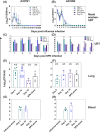Infection with different human influenza A subtypes affects the period of susceptibility to secondary bacterial infections in ferrets
- PMID: 37332495
- PMCID: PMC10117794
- DOI: 10.1093/femsmc/xtac011
Infection with different human influenza A subtypes affects the period of susceptibility to secondary bacterial infections in ferrets
Abstract
It is well-established that influenza virus infections predispose individuals to secondary bacterial infections (SBIs), which may result in a range of clinical outcomes from relatively mild (e.g. sinusitis and otitis media) to severe (e.g. pneumonia and septicaemia). The most common bacterial pathogen associated with SBI following influenza virus infections is Streptococcus pneumoniae(SPN). Of circulating human seasonal influenza viruses, influenza A viruses (IAV) of both the A(H1N1)pdm09 and A(H3N2) subtypes are associated with severe disease but have differing hospitalisation and complication rates. To study the interplay of these two IAV subtypes with SBI, we used a ferret model of influenza infection followed by secondary challenge with a clinical strain of SPN to determine the severity and the period of susceptibility for SBI. Ferrets challenged with SPN 5 days after infection with A(H3N2) or A(H1N1)pdm09 viruses developed severe disease that required euthanasia. When the time between viral infection and bacterial challenge was extended, A/H1N1pdm09-infected animals remained susceptible to SBI- for up to 10 days after the viral infection. For A(H3N2)- but not A(H1N1)pdm09-infected ferrets, susceptibility to SBI-associated disease could be extended out to 16 days postviral infection. While caution should be taken when extrapolating animal models to human infections, the differences between A(H3N2) and A(H1N1)pdm09 strains in duration of susceptibility to SBI observed in the ferret model, may provide some insight regarding the higher rates of SBI-associated disease associated with some strains of A(H3N2) viruses in humans.
Keywords: Influenza A virus; Streptococcus pneumoniae; community acquired pneumonia; ferrets; septicemia; viral bacterial coinfections.
© The Author(s) 2022. Published by Oxford University Press on behalf of FEMS.
Conflict of interest statement
None declared.
Figures



References
-
- Brueggemann AB, Peto TE, Crook DWet al. . Temporal and geographic stability of the serogroup-specific invasive disease potential of Streptococcus pneumoniae in children. J Infect Dis. 2004;190:1203–11. - PubMed
-
- Burrell A, Huckson S, Pilcher DV. ICU admissions for sepsis or pneumonia in Australia and New Zealand in 2017. N Engl J Med. 2018;378:2138–9. - PubMed
-
- Cawcutt K, Kalil AC. Pneumonia with bacterial and viral coinfection. Curr Opin Crit Care. 2017;23:385–90. - PubMed
LinkOut - more resources
Full Text Sources
